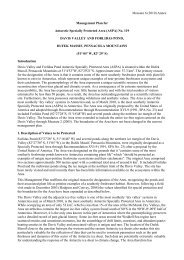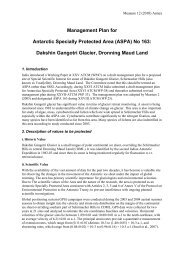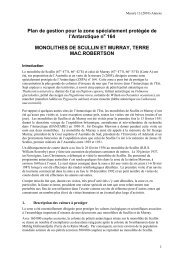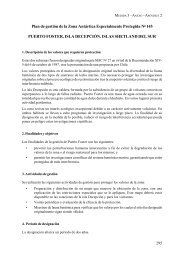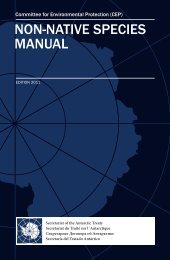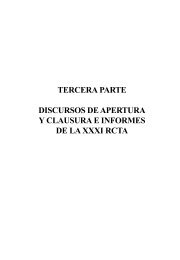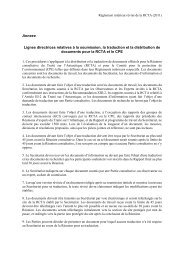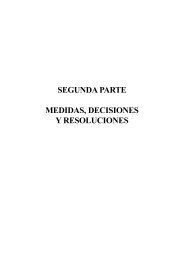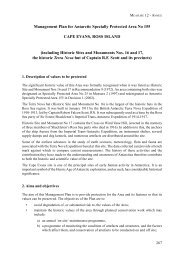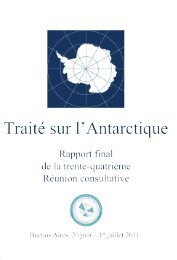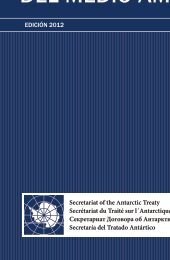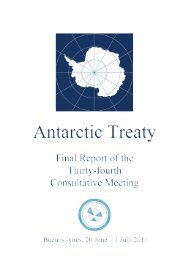Scott Base and McMurdo Station - Antarctic Treaty Secretariat
Scott Base and McMurdo Station - Antarctic Treaty Secretariat
Scott Base and McMurdo Station - Antarctic Treaty Secretariat
Create successful ePaper yourself
Turn your PDF publications into a flip-book with our unique Google optimized e-Paper software.
3. SCOTT BASE (NEW ZEALAND)3.1 GENERAL INFORMATIONThe inspection of <strong>Scott</strong> <strong>Base</strong> was undertaken on 21 <strong>and</strong> 22 January 2005. Supplementary observations weremade on 23, 24 <strong>and</strong> 25 January. No aerial observations of <strong>Scott</strong> <strong>Base</strong> were made.<strong>Scott</strong> <strong>Base</strong> is on Ross Isl<strong>and</strong> at 77º51’S, 166º45’E. The base is operated by New Zeal<strong>and</strong>. <strong>Scott</strong> base wasestablished to support the Trans <strong>Antarctic</strong> Expedition <strong>and</strong> the International Geophysical Year, <strong>and</strong> has beencontinuously operated by New Zeal<strong>and</strong> since its official in January 1957.Progressive replacement of the original base with more permanent structures commenced in 1976, <strong>and</strong>completion of the rebuilding will be achieved in 2005 with the commissioning of the new Hillary Field Centre.Two old buildings survive. The station now provides approximately 3000 m 2 of heated accommodation <strong>and</strong> workspace. Ancillary structures provide a further 400 m 2 <strong>and</strong> the Hillary Field Centre will provide an additional 900m 2 when commissioned.<strong>Scott</strong> <strong>Base</strong> supports scientific research at the station itself <strong>and</strong> in the immediate vicinity of Ross Isl<strong>and</strong>. Inaddition, the base acts as a major logistics hub for scientific activities further afield throughout the Ross Searegion. These programmes include the international ANDRILL project, as well as smaller studies of theatmosphere, the <strong>Antarctic</strong> ecosystem, geophysics, glaciology, climate, physiology, sea ice <strong>and</strong> oceanography. <strong>Scott</strong><strong>Base</strong> also supports visits by heritage conservation experts, media <strong>and</strong> artists.There are several scientific facilities at <strong>Scott</strong> <strong>Base</strong> including the Hatherton Geosciences Laboratory; wetlaboratory; dry laboratory; magnetic variometer hut <strong>and</strong> magnetic absolute hut. Some of the scientificinstrumentation has been making continuous readings of geophysical observations for many decades. As for allthe <strong>Scott</strong> <strong>Base</strong> buildings, the scientific facilities are well maintained. There are approximately 200 metres of gravelroad at <strong>Scott</strong> <strong>Base</strong> to provide access between buildings. These connect to the road that links <strong>McMurdo</strong> stationwith ice shelf airfields.At the time of the inspection <strong>Scott</strong> <strong>Base</strong> was under the comm<strong>and</strong> of Mr Julian Tangaere, <strong>Base</strong> Manager. Up to85 people can be accommodated at the base <strong>and</strong> approximately 70 people were on base at the time of our visit.Of these, around half were domestic, engineering <strong>and</strong> logistic staff employed to run the base <strong>and</strong> support peopleworking on the base itself <strong>and</strong> the scientists <strong>and</strong> other personnel in transit to field locations. A high proportionof visitors to the base are in transit to field locations or are short term visitors to undertake specific scientific orengineering projects. An 8-person contract construction crew was present throughout summer to erect the newHillary Field Centre. 10 people will maintain <strong>Scott</strong> <strong>Base</strong> <strong>and</strong> year-round scientific projects over the 2005 winter.3.2 OBSERVATIONS - ANTARCTIC TREATYUse of <strong>Antarctic</strong>a for peaceful purposes (Article I)<strong>Antarctic</strong>a New Zeal<strong>and</strong> operates a civilian scientific program. No military activities or armaments were observedat <strong>Scott</strong> <strong>Base</strong>. The New Zeal<strong>and</strong> Defence Force assists with the provision of personnel at <strong>Scott</strong> <strong>Base</strong>, includingthe <strong>Base</strong> Services Manager, communications staff, cargo h<strong>and</strong>lers <strong>and</strong> canteen management. The Royal NewZeal<strong>and</strong> Air Force provides aircraft <strong>and</strong> personnel to support flights between New Zeal<strong>and</strong> <strong>and</strong> Ross Isl<strong>and</strong> as acontribution to a logistics pool arrangement also involving the United States <strong>and</strong> Italian <strong>Antarctic</strong> programs.Military personnel in support of these activities are accommodated <strong>and</strong> managed out of <strong>McMurdo</strong> <strong>Station</strong>. Nomilitary personel are at <strong>Scott</strong> <strong>Base</strong> during the winter period.Freedom of scientific investigation (Article II)There are multiple examples of New Zeal<strong>and</strong>’s commitment to freedom of scientific investigation. <strong>Scott</strong> <strong>Base</strong> hasbeen occupied continuously since the International Geophysical Year.Exchange of scientific information <strong>and</strong> personnel (Article III)Information about New Zeal<strong>and</strong>’s scientific programs in <strong>Antarctic</strong>a is publicly available <strong>and</strong> readily accessible inprinted form <strong>and</strong> through the internet. Scientists from Australia, Italy <strong>and</strong> South Africa were present at <strong>Scott</strong> <strong>Base</strong>during the visit of the observer team. During 2004/05 scientists from seven other <strong>Antarctic</strong> <strong>Treaty</strong> Partiesparticipated in the New Zeal<strong>and</strong> programme, as well as scientists from Malaysia.The results of New Zeal<strong>and</strong>’s <strong>Antarctic</strong> scientific observations are published in a range of scientific journals <strong>and</strong>copies of many past scientific publications were seen at <strong>Scott</strong> <strong>Base</strong>. The forward science program is described inNew Zeal<strong>and</strong> Science in <strong>Antarctic</strong>a <strong>and</strong> the Southern Ocean (2004-2009) which is publicly available <strong>and</strong> promotesinternational cooperation in pursuit of the strategic research objectives.



